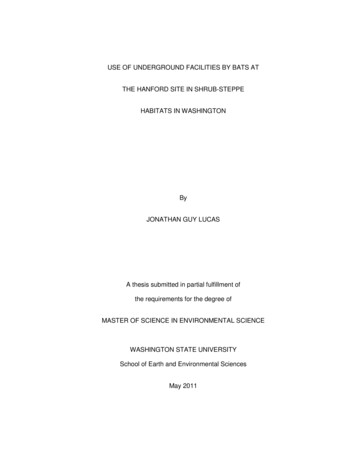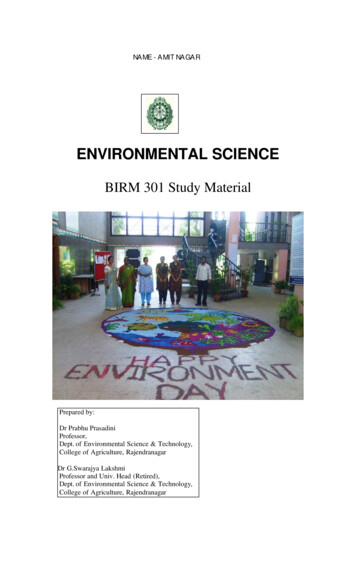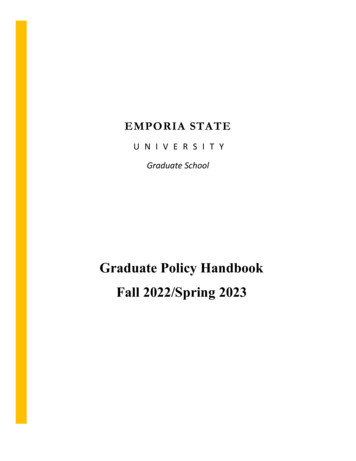
Transcription
USE OF UNDERGROUND FACILITIES BY BATS ATTHE HANFORD SITE IN SHRUB-STEPPEHABITATS IN WASHINGTONByJONATHAN GUY LUCASA thesis submitted in partial fulfillment ofthe requirements for the degree ofMASTER OF SCIENCE IN ENVIRONMENTAL SCIENCEWASHINGTON STATE UNIVERSITYSchool of Earth and Environmental SciencesMay 2011
To the Faculty of Washington State University:The members of the Committee appointed to examine the thesis of JONATHAN GUYLUCAS find it satisfactory and recommend that it be accepted.Rodney Sayler, Ph.D., ChairLee Rogers, Ph.D.Kenneth Gano, MSc.ii
ACKNOWLEDGMENTI gratefully acknowledge my bat project coworkers Ken Gano and Cole Lindsey for theirsupport and friendship on this project, and Pat Ormsbee and the Bat Grid crew for theirawesome training and support. I also thank my committee members Dr. Rod Sayler, Dr. LeeRogers and Ken Gano for taking me through this process of learning. I especially thank my wifefor her support and patience through my schooling.iii
USE OF UNDERGROUND FACILITIES BY BATS ATTHE HANFORD SITE IN SHRUB-STEPPEHABITATS IN WASHINGTONAbstractby Jonathan Guy LucasMasters in Environmental ScienceWashington State UniversityMay 2011Chair: Rodney D. SaylerWildlife habitat conservation on military and other large publically owned landscapes iswidely recognized as critical in the United States given continuing human population growth,increasing intensity of land use, and the large number of threatened and endangered speciesoccupying these lands. The Department of Energy’s, Hanford Site, in south central Washington,was established in 1943 for atomic bomb material production during World War II. The HanfordSite encompasses 1517 km2 (151,773 ha) of shrub-steppe landscape and now represents oneof the largest blocks of such habitat in Washington. Plutonium production ended at the HanfordSite in the late 1980’s and contaminant remediation began in 1989. As part of this long-termcleanup and shutdown process, we studied two sites with bat colonies (183-F clearwell andthe190-D/DR process water tunnels) to determine the extent of bat use of constructed facilities(e.g., buildings, underground tanks and tunnels), scheduled for removal or closure. Weconducted mist-netting, acoustic monitoring, infrared (IR) videotaping, and visual surveys fromAugust 2007 to August 2010 to determine the potential importance of constructed facilities toiv
regional bat populations. Approximately 3600 bats were discovered at 183-F, while about 340bats were found at the 190-D/DR water tunnel, with each site containing maternity colonies.Genetic analysis of wing punch tissue from both colonies indicated the presence of Yumamyotis (Myotis yumanensis) and revealed ten overlapping matrilines between the two colonies,but no significant difference in their frequencies. Acoustic monitoring at 183-F indicated springand summer maternity activity started to increase about mid-March. Surprisingly, someacoustic calls were recorded through fall and winter, with calls still being recorded down tominimum air temperatures of 13.8 0 C (7.1 0 F), indicating that not all individuals left the HanfordSite during winter. The 183-F clearwell is the largest known maternity colony of Yuma myotis(Myotis yumanensis) in Washington State and demonstrates the importance of assessingartificial structures potentially slated for removal or modification to assess their ecologicalimportance for western bat species. Consequently, the 183-F structure was saved frompotential future demolition and remains an important resource supporting regional batpopulations.v
ContentsACKNOWLEDGMENT . iiiAbstract . ivIntroduction . 1Study Area . 3Methods . 7Field Sampling . 7Results . 9Discussion . 12Literature Cited. 16vi
List of TablesTable 1. Summary of bat species identified in studies conducted on the Department of Energy’sHanford Site, Washington, 1991– 2008. . 20Table 2. Age and Reproductive Status of Bats Captured at the 183-F and 190-DR, 8-27-07 through 918-07. . 22List of FiguresFigure 1. U.S. Department of Energy’s Hanford Site, in south-central Washington State. . 23Figure 2. Installed bat gate at the entrance to the Yuma myotis (Myotis yumanensis) maternitycolony at the 190-DR Process Water Tunnel. . 24Figure 3. Frequency of maternal genetic lines (matrilines) at two study sites on the Hanford Site,Washington, identified through mtDNA analysis of Yuma myotis (Myotis yumanensis). . 25Figure 4. Bat acoustic activity collected by using an AnaBat SD-1 acoustic recorder stationed outsidethe 183-F East Clearwell Flume flume entrance, October 9, 2007 to February 19, 2008. . 26Figure 5. Bat acoustic activity collected by using an AnaBat SD-1 acoustic recorder stationed outsidethe 183-F West Clearwell access hatch, February 20, 2008 to June 29, 2008. 27Figure 6. 183-F Clearwell ceiling temperature recorded October 3, 2007 to September 6, 2008. Leftarrow on X-axis indicates approximate start of maternity colony activity and right arrow the time ofyoung fledging. 28vii
IntroductionThe United States federal government currently owns and manages about 264 millionhectares (652,358,207 acres) of land, which is nearly 29% of the United States (Stein et al.2008). The Department of Defense manages over 10 million ha (25 million acres, includinghabitat for some 220 endangered species (Burton and Williams 2001). The Department ofEnergy manages nearly 1 million ha (2.4 million acres) on about 50 sites. While the importanceof private lands are critical to the conservation of many species (Hilty and Merenlender 2003), itis increasingly recognized that federal and state lands also provide protection for importanthabitats for many species for a variety of reasons, especially the protection of large, relativelyundisturbed landscapes that might otherwise have been developed. In the arid western U.S.,large expanses of the shrub-steppe ecosystem have been lost to farming, ranching, orcatastrophic fires (Dobler et al. 1996), to the point that the conservation of this ecosystem and alarge number of constituent plant and animal species is a matter of increasing conservationconcern.The Department of Energy’s, Hanford Site (Fig. 1), in south central Washington, wasestablished in 1943 for atomic bomb material production during World War II as part of theManhattan Project. Production and use of chemical and radiological materials occurred therefrom about 1943 to the late 1980s. The Hanford Site encompasses 1517 km2 of shrub-steppelandscape and now represents one of the largest remaining blocks of such habitat inWashington (Dobler et al. 1996). Weapons production ended on the Hanford Site in thelate1980’s and environmental remediation of the entire site began in 1989. As part of this longterm shutdown and cleanup process, we studied two facility sites harboring bat colonies (183-Fclearwell and the 190-D/DR process water tunnels) to determine the extent of bat use of1
constructed facilities (e.g., buildings, underground tanks, and tunnels) scheduled for removal orclosure.Numerous environmental and ecological studies on fish, ungulates, rodents, and birdshave been conducted on the Hanford Site since 1943 to assess the potential biological uptakeof any chemical or radiological contaminants caused by weapons production. However,relatively little information is available on species richness, abundance, distribution, habitatrequirements, and other basic ecological information on bats occupying either the Hanford Siteor the shrub steppe ecosystem in central and eastern Washington (Christy et al 1995 andGitzen et al 2002). Due to their secretive and nocturnal nature, bats are difficult to study orrequire specialized techniques and equipment to survey populations, and consequently,relatively few such studies have been undertaken on the Hanford Site (Table 1).Major constructed facilities, such as buildings, towers, and underground structures (e.g.,tunnels and underground water storage basins) have been in place on the Hanford Site sinceabout 1943. While these facilities were not intended for use by wildlife, bats routinely colonizebuildings and other human-built structures for day and night roosting or even as nursery sites forrearing young (Kunz and Reynolds 2003, Lausen and Barclay 2006 (b)). Because such artificialhabitat is limited on the Hanford Site, more information is needed to determine the ecologicalimportance of these facilities and the potential effects of their closure or removal on batpopulations. We studied bat communities at the Hanford Site from 2007 to 2010 to determinewhich species were present, understand genetic relationships of populations at several differentfacilities, and to describe how bats were using artificial structures that were scheduled fordemolition. This information is important for conservation planning for bats, because it revealsthe unintended consequences of human development on local wildlife populations, and it also2
illustrates the relatively unseen potential importance of artificial structures as habitat for bats.Two locations with apparent bat activity are known to occur on the Hanford Site, the 100D/DR reactor process water tunnels and the 100-F reactor underground filtered water storagebasins (i.e., clearwell basin). These sites and other former nuclear reactor sites along theColumbia River are currently being remediated under direction of the U.S. Department ofEnergy (DOE). The overall objective of this study was to support the DOE's Columbia Rivercorridor cleanup process and potentially guide how bat habitats are managed during thisprocess. Our study on the Hanford Site specifically was designed to: 1) describe existing batpopulations (i.e., species identification; estimate population size and sex/age structure), 2)assess patterns of daily and seasonal use of constructed facilities (e.g., presence of lactatingfemales and size of maternity colonies), and 3) determine the potential biological and ecologicalimportance of facilities to local and regional bat populations. Our working hypothesis, based onthe apparent general mobility and seasonal movements of bats in temperate regions, was thatthere would not be substantial genetic differentiation among bat populations at different facilitieson the Hanford Site. We collected wing-punch tissue samples and analyzed maternal DNAstructure for one species of vesper bat, Yuma Myotis (Myotis yumanensis), as a first steptoward evaluating this working hypothesis.Study AreaThe Hanford Site includes nine reactor facilities built on six sites along the Columbia River.In 1989, four large parcels of land at the Hanford Site were placed on the National Priorities List(NPL) under the authority of the Comprehensive Environmental Response, Compensation, andLiability Act of 1980 (CERCLA) for environmental cleanup. One of these parcels is known asthe 100 Areas where the former plutonium production reactors are located along the ColumbiaRiver. Placement on the NPL initiated the CERCLA process that would lead to the3
environmental remediation of radioactive or chemically contaminated areas. Waste site cleanupunder interim action Records of Decision (RODs) was initiated during the mid-1990s, and the100 Areas are planned for completion of remediation efforts by 2013. The cleanup plan for thereactors is to demolish and remove all associated structures, including support facilities, andseal up the reactor buildings by installing new roofs to prevent animal intrusions. The intent is toplace the reactors in a state of Interim Safe Storage (ISS) for final demolition at a later date.During the cleanup and demolition of various reactor facilities, workers have observed bats onnumerous occasions. Dead specimens have been collected over time and preserved in theR.E. Fitzner Natural History Collection located at the Washington State University, Tri-Citiescampus, Richland, Washington.Previous bat related projects have been associated with ISS projects, conducted at tworeactor sites, the 105-DR reactor and 105-F reactor, to mitigate for roosting habitat that was lostbecause of cleanup projects. Ecological reviews conducted by Washington Closure Hanford(WCH) prior to the initiation of these projects, identified the presence of multiple bat speciesutilizing the reactors as maternity roosts for rearing young. Two species of Myotis bats,including Yuma myotis (Myotis yumanensis) and Western small-footed myotis (Myotisciliolabrum) have been found at both areas, while Pallid bats (Antrozous pallidus) occur at the105-F Reactor (Johnson and Gano 2006).The first study site is located at River Mile 377.5 on the Columbia River at the 190-DRprocess water tunnels. This site is located 13.0 km (8.1 mi) upstream of the 100-F reactor site,and the tunnels are located approximately 0.97 km (0.6 mi) from the Columbia River shoreline.The 105-D reactor operated from 1944 to 1967 and the 105-DR reactor operated from 1950 to1964 (DeNeal 1970). Mitigation projects at 100-D Area were initiated when a bat colony (Myotissp.) was discovered in one of the process water tunnels connected to the 105-DR Reactor. The4
ISS Project Plan included isolating the tunnels from the reactor, which would eliminate bataccess to the tunnels and cause the loss of the maternity roost. Approval and concurrence fromthe U.S. Department of Energy, Richland Operation Office on July 28, 1998, provided directionto maintain bat access and mitigate for roosting habitat that would be lost as a result of the ISSproject. Alternate accesses were provided on both tunnel systems that entered the 105-DRreactor valve pit by installing bat gates on access hatches (Figure 2). One tunnel originated atthe 190-D Water Pump House, as a redundant water supply, and two tunnels originated fromthe 190-DR Water Pump House and come together just west of the valve pit. The originalpurpose of these tunnels was to provide the primary cooling water supply for the 105-DRReactor. The non-contaminated process water tunnels were built with a zig-zag design to allowfor expansion of the piping. Each straight leg of the tunnels contains a surface hatch to provideaccess in case a pipe section had to be replaced. The bat gates were placed over hatches onboth tunnel systems. The gate on the 190-D tunnel was installed in the fall of 1998, and thegate on the 190-DR tunnel system, fall of 1999.Monitoring of bat roosting began in July 1999. The 190-D tunnel has not been enteredsince the reactor valve pit was backfilled, because there is no walk-in access available. The190-DR tunnels have had walk-in access that has allowed inspections of the tunnels. Theseinspections were conducted from 2002 to 2005 and the number of bats roosting in the hatchesranged from 97 to 170 bats (Johnson and Gano, 2006).The second study site is located at the former 100-F nuclear reactor facility (River Mile369), about 41.0 km (25.5 mi) north of Richland, Washington, and is located 430 m (1,410 ft)from the shoreline of the Columbia River. The 105-F reactor's former 183-F clearwell facility,was reported in 2006 to contain is an estimated 1000 to 2000 bats of unknown species (Ganoand Lucas 2006). Bats were first noticed near this facility in the summer of 2003 (Gano 2006).5
The 105-F reactor was in operation from 1945 to 1965 (DeNeal 1970). This site consists of twounderground 14,157 kiloliter (3,740,000 gal) concrete basins called “clearwells” that held clean,filtered river water from the water treatment plant. The facility was used to store filtered riverwater prior to being used as cooling water in the 105-F Reactor. Each clearwell is about 41 m(134 ft.) wide by 114 m (375 ft.) long by 5 m (16 ft.) deep. The east clearwell has beendemolished and backfilled with soil.The roof of the west clearwell is a 15.2 cm (6 in) thick concrete slab supported by interiorcolumns. Bats have been using the west clearwell and are entering and exiting through anopen maintenance hatch that is 106.7 cm (42 in) square that was opened at an unknown timemany years ago. On the north side of both clearwells there is a 229-m ( 750-foot) longunderground concrete flume that is 1.3 m wide by 2 m high (4 ft by 6.6 ft) that functioned as adrain for the water treatment plant. Bats appear to be utilizing this flume to an unknown extent(Gano and Lucas 2006). It was unknown how bats were utilizing the western clearwell or theflume. No studies had been conducted to identify the species present, their relative abundance,or how the bats were utilizing these structures in the spring and summer, or potentially thewinter. As part of the River Corridor Closure contract carried out for the Department of Energy,the 183-F clearwell facility was scheduled for demolition. Before demolition could take place,the impacts that demolition would have on the bats roosting in the structures needed to beunderstood.The two study sites are surrounded by shrub-steppe vegetation, dominated by Bigsagebrush (Artemisia tridentata) with bunchgrass understory (DOE/RL 96-32). At first farmingand then construction of the Hanford Site in 1943 and development of the reactor areas hasdisturbed much of this native plant community near the Columbia River. This disturbance hasallowed the extensive introduction of non-native species such as cheatgrass (Bromus tectorum),6
Russian thistle (Salsola kali), and tumble mustard (Sisymbrium altissimum). The majority of theHanford Site, however, remains relatively undisturbed and functions as a sanctuary to manynative plant and wildlife species.MethodsField SamplingBats were captured during eight nights at both study sites from August 27, 2007 to May27, 2008 utilizing a bat mist net (Avinet) set near the identified roosting sites at each of the twostudy sites during the bats’ active season, which is from mid-March through September(personal observations). Nets were set at locations to optimize capture near emergenceopenings, but not so close as to interfere with emergence. Based upon previous observationsof bat emergence times and duration, nets were open from about 15 to 20 minutes after sunsetto at least one hour after bat emergence occurred, which is typically 30 minutes after sunset, sothat a representative sample of the population at the study site was collected. Mist nets wereopen for an average of 2 hours per netting session. Data were collected from captured bats thatincluded age (adult or sub-adult), forearm length, sex, reproductive status, species, weight, anda 3-mm wing membrane tissue punch. These data were collected using protocols establishedby the Bat Grid Inventory and Monitoring Project (2010) and Vonhof (2002).Determination of the species of the bats captured at both sites was conducted bycollecting a 3-mm wing membrane punch from captured bats between their third and fourthfinger on the left wing. Twenty two wing membrane tissue samples from the 190-DR study andsixty three wing membrane tissue samples from the 183-F study site were sent to Portland StateUniversity (PSU) for genetic analysis of mitochondrial DNA (mtDNA) to identify species usingmethods described in Zinck et al. 2004. Genetic analysis of mtDNA, specifically Myotis7
yumanensis, to identify matrilines (i.e. maternal lines) for both study sites was determined permethods described in Vonhof et al. 2008. All genetic analysis was conducted by Dr. Jan Zinckat PSU. We used a two-tail Z-test for comparing the frequency of the matrilines identified fromgenetic analysis of tissue samples collected at each of the sites.Population size and emergence time for bats was estimated by videotaping theemergence of each study site population using a Sony Night Shots video camera (model #DCR-TRV103) with auxiliary IR (infrared) lights for two hours, and by visual counts of roostingbats. Total emergence was estimated by counting the number of bats observed (on therecording) emerging from the roost sites for each minute over the two hour video tape recording.We assessed whether the study sites were also maternity colonies by recording thereproductive condition of adult female bats captured during mist-netting sessions. Because ofthe challenges of conducting an emergence count from a bat gate, due to multiple emergencepaths and bats returning to the roost, a bat “out” minus bats “in” count was conducted, and thegiven count is possibly a conservative estimate of the actual numbers of emerging bats.We determined seasonal activity patterns for bats by examining temporal (spring,summer, autumn and winter) usage patterns of the 183-F clearwell through collection ofacoustic data at roost entrances utilizing an AnaBat SD-1 acoustic detector and visual roostsurveys. All acoustic data was collected by setting up an AnaBat SD-1 detector in a weatherprotected enclosure on a post with the microphone pointing down toward a board set atapproximately 45 degrees. The detector was set to turn on at approximately 1600 hrs and turnoff at approximately 0700 hrs. AnaBat acoustic data was analyzed using an “Allbats” detectionfilter (Corben, C. 2010). Acoustic signals, which are composed of a series of frequency pulsesthat were of a quality to pass the filter, were counted as bat detection.8
ResultsIn August 2009, an emergence count at the 183-F clearwell and clearwell flume entrancewas conducted; and the total emergence was estimated to be 2,640 individuals from theclearwell hatch, and approximately 120 bats from the flume entrance (WCH-362). Emergencecounts were again conducted in 2010 at the 183-F clearwell, with a count of 3,539 in June and3,637 in August. Numbers seem to indicate a growing colony, but more yearly counts would beneeded to better assess this trend.The 190-D process water tunnel was isolated from the 190-DR process water tunnelwhen the ISS project at 105-DR reactor demolished the valve pit where the tunnels entered thereactor. Each tunnel now has its own bat gate and Yuma myotis use both process tunnel gates,although separated, both tunnels likely function as one maternity colony because of theirproximity. Counts of bats in the 190-DR tunnel have been conducted in previous years duringwalk-throughs of the tunnel by visually counting bats seen roosting in the tunnel. The numberscounted were 107 in 2002, 99 in 2003, 98 in 2004, 97 in 2005, a second survey in 2005indicated 170, 108 in 2007, 67 in 2008, and 77 in 2009 (WCH-288 and WCH-362).Approximately 340 Yuma myotis were counted emerging from the 190-D water process tunnelgate in July, 2010. Because of the proximity of the two tunnels, the bats could easily move fromone tunnel to the other throughout the season which could account for the variability in thepopulation counts done inside the 190-DR tunnels, including the timing of the counts also.9
Sex, age and reproductive status information collected during mist-netting at both studysites indicated a high percentage of females compared to males, and high percentages of postlactating and parous females. This data shows that both sites contain maternity colonies(Table 2).Genetic analysis performed on tissue samples from bats using the 183-F (n 63) and190-DR (n 22) study sites resulted in all samples being identified as Yuma myotis. MaternalmtDNA analysis yielded ten matrilines (labeled A through J) from both study sites. The relativefrequencies of the matrilines sampled at the two roosting sites were not significantly different(Figure 3).To describe seasonal activity patterns of bats using the tunnels and clearwell, wecollected automated acoustic recordings to detect bats outside the 183-F clearwell emergencehatch and the clearwell’s east flume entrance from October 9, 2007 through June 29, 2008(Figures 4 and 5). A large decrease in bat acoustic activity occurred around October 17, 2007,and activity levels appeared to drop to low winter levels by about November 9, 2007. By lateMarch of 2008, bat activity increased rapidly from low winter activity to higher spring andsummer activity levels (Fig. 5).10
One interesting record of bat activity occurred January 23 to 24, 2008 when five acousticbat passes were detected when an average minimum nighttime temperature of -13.8oC (7.1oF)was recorded at a weather station about 2.8 km south of the 183-F study site. This observationcorrelated with a study of winter bat activity in southeastern Alberta, Canada, where bats weremonitored at two rocky areas along the Red Deer River. Bats were found to be active evenwhen ambient temperatures were below 0 oC during the day and night; the coldest temperatureobserved with bat activity was -8 oC (Lausen and Barclay 2006 (a)). What is behind winteractivity is not well understood, and much more study is needed in this particular area of batecology (Falxa 2007, and Lausen and Barclay 2006 (a)).We collected ad hoc observations of roosting bats observed during entries into the 183-Fflume to deploy and retrieve a temperature and humidity data logger. We observedapproximately 200 to 300 Yuma myotis roosting within the first 90 meters of the flume entranceon October 3, 2007 during data logger deployment. These bats were observed roosting inclusters on the cement wall near the ceiling of the flume. On September 30, 2008 we enteredthe flume again to retrieve the data logger, and observed approximately 200 Yuma bats roostingin clusters near the ceiling and in a ceiling pipe annulus. The roosting clusters were composedof both male and female bats based upon hand capture identification of a small sample of bats.An entry was made inside the 183-F clearwell during June 2008 to videotape thematernity colony when the females would be present in high numbers with associated maternalactivity. Filming with IR lighting showed that the females were in large clusters on roof supportcolumns near the ceiling. Clearwell ceiling temperatures later obtained from a data logger wereapproximately 10oC (50oF) in early April at the beginning of maternity colony activity and about32oC (90oF) by the time the pups fledged at the end of June (Fig. 6).11
In addition to acoustic recordings, we also conducted occasional mist-netting sessionsonce or twice during spring and summer. We captured a male Western small-footed myotis(Myotis ciliolabrum) at the 183-F study site on August 18, 2009, along with the expected Yumamyotis. The male was light-tagged per Bat Grid Inventory and Monitoring Project (2010)protocols, so an acoustic call could be recorded. The bat flew around for a few minutes, andthen it was observed flying into the clearwell through the roof hatch of the 183-F clearwell,where the Yuma myotis colony is located. Other Western small-footed myotis occasionally havebeen captured and acoustically recorded at other nearby reactor sites, which may indicate theyare using the same common roosting areas as the Yuma myotis.DiscussionAbout 10 species of bats have been identified on the Hanford Site since 1991; however,accurate identification of western bat species can be difficult because of morphologically crypticspecies (Weller et al. 2007). Increasingly, molecular techniques are being employed todiscriminate among cryptic species and help define morphological characteristics useful inidentifying bats (Zinck et al. 2004; Weller et al. 2007). Nonetheless, even if the accuracy ofhistorical identifications is unknown, this apparent diversity of bats on the Hanford Site is eithercomparable or relatively high for that known for other areas in eastern Washington and othershrub-steppe habitats in the inland Pacific Northwest (Gitzen et al 2002). Buildings,underground tunnels, clearwells, flumes, and other structural facilities on the Hanford Siteobviously were never designed with the intention that they would be used by wildlife. However,our surveys demonstrate that bats have readily colonized and now occupy some of these sitesin high densities. Furthermore, our study demonstrates that both bat roosting areas arematernity colonies for Yuma myotis (Myotis yumanensis). High percentages of the females inthese roosts are parous or post-lactating, which is indicative of maternity colonies and a large12
proportion of adult females we observed were raising pups during the breeding season.Bats are homeothermic and maintain a body temperature of about 35o to 39oC (95o to102oF), and consequently, they attempt to
R.E. Fitzner Natural History Collection located at the Washington State University, Tri-Cities campus, Richland, Washington. Previous bat related projects have been associated with ISS projects, conducted at two reactor sites, the 105-DR reactor and 105-F reactor, to mitigate for roosting habitat that was lost because of cleanup projects.











